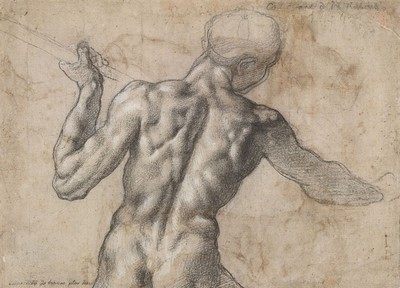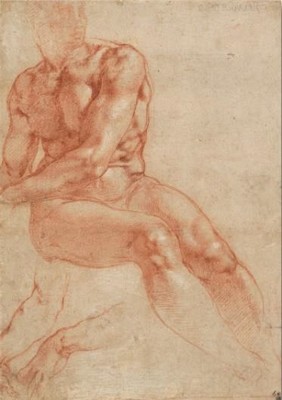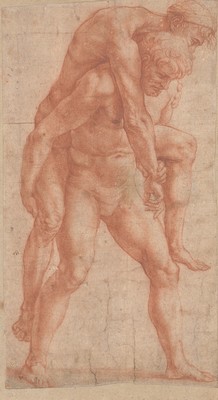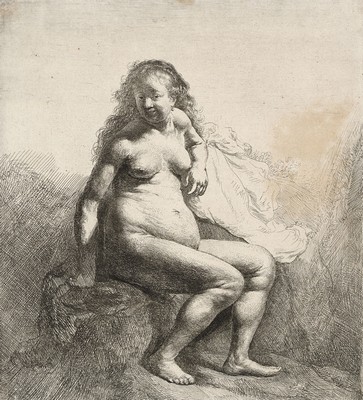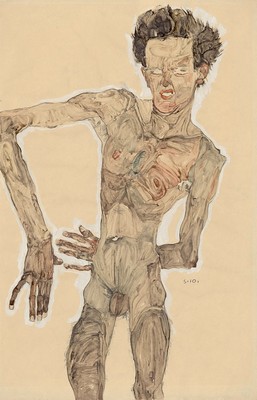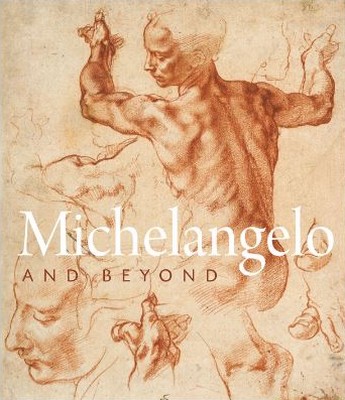Michelangelo and Beyond
ALBERTINA Museum, Vienna
15 September 2023 - 14 January 2024
Male Nude Seen from Rear, c. 1504
Black chalk, heightened with white, 20 x 27 cm
The ALBERTINA Museum, Vienna
Seated Nude Youth and Two Arm Studies, 1510/11
Red chalk, heightened with white, 28 x 19 cm
The ALBERTINA Museum, Vienna
The master of the Renaissance: Michelangelo is one of a handful of artists whose fame has been unwavering for centuries. Although his art and his ideals are deeply rooted in the attitudes of the time – the heyday of the Renaissance and the progressive 16th century – the impact of his work extends into the present day.
Every century experiences its own Michelangelo Renaissance, and in doing so revives the historic ideal of the perfect male nude developed by the prominent Florence native on an unrivalled scale through his drawings for the incomplete fresco the Battle of Cascina, the Ignudi in the Sistine Chapel and the Dying Slave for the tomb of Pope Julius II.
Michelangelo and Beyond deals with the emergence and the power, the decrease in significance and the decline of a canon – a canon on which Michelangelo and his works made a lasting impression 500 years ago – and how the generations that followed have approached this template since.
The depiction of the human body
The richly populated portfolio of graphic pieces at the ALBERTINA allows for examination of the Michelangelo ideal, which is strikingly conveyed in both his drawings and his sculptures as the athletic and powerful male nude, whose inner tension appears to want to burst out of the body.
The new status of the drawing as its own work of art in the 15th century solidified the artistic concept and the temperament of the artist, and was reflected by the high demand of collectors for these valuable items. The provenance of the drawings by the Renaissance master at the ALBERTINA shows Peter Paul Rubens to be the owner in the 17th century, which highlights the importance of the Italian genius for subsequent generations of artists.
Adam and Eve, 1504
The ALBERTINA Museum, Vienna
A Young man Carrying an Old Man, 1514
The ALBERTINA Museum, Vienna
The Gret Hercule, 1589
The ALBERTINA Museum, Vienna
Naked Woman Seated on a Mound, c. 1631
The ALBERTINA Museum, Vienna
On the one hand, the classical nude as we encounter it in the drawings in the ALBERTINA Museums’ Collections, from Michelangelo to Raffael and Beccafumi to Bandinelli, da Volterra and Salviati, always strives for the harmonious balance between generic formulas like standardised poses, the study of the anatomy according to ancient sculptures or the full-scale outline of body parts according to the formalised proportions of the Vitruvian man, and emulating nature on the other hand.
With their opposing positions, artists Rembrandt and Rubens shape the Baroque period. Rubens deals with the real, living model and brings back ancient nakedness in a new guise.
Rembrandt, on the other hand, doesn’t shy away from portraying the ugliness of the authentic body, of people in their impermanence and weakness. In doing so, he strikes a harsh contrast with the athletic body of Buonarroti.
In Classicism, the image of the beautiful and muscular naked male body continues. Almost 200 years after the death of Florence’s master, the Michelangelesque canon finds its sequel in the prevalent depiction of the ideal nude. The painters of the time, such as Anton Raphael Mengs or Pompeo Girolamo Batoni, create works that return to Michelangelo with their precision in shaping the musculature, the portrayal of complicated poses and perspective foreshortening contingent on complex postures. They are particularly reminiscent of his superlative drawings, associated with works like the Battle of Cascina or the ceiling fresco in the Sistine Chapel.
Just as slavishly and anachronistically, artists in the time of Klimt and Schiele imitate the heroic, athletic design, but more outwardly, superficially, without the intellectual depth of Buonarroti. This canon, shaped by Michelangelo, finally reaches its peak, as the depiction of the male nude as a symbol of a heroic individual finds increasingly diminishing resonance in modern society.
The exhibition bears the historic sign that for centuries, only men drew men, and women were also only drawn by men. A man defined the canon of the male nude to the extent of that of the female nude. Michelangelo himself drew very few naked women, instead lending the male body a feminine grace.
A woman in art is like the dark side of the moon: you know it exists, but it’s terra incognita. In a few typical examples from the 17th and 18th centuries, the exhibition displays the unrealistic ideal of the woman. For a long time, the depiction of a naked woman was discriminated against and discredited for identifying with vices, immorality and sexual instincts. The immorality of women leads to death and sin in the form of Eve; the sexual instinct of Luxuria appears vain and naked. The virtuous are largely cloaked in flowing robes. The antithesis of virtuously veiled women describes the naked woman as a female force, as a witch, as a seductive Venus.
The outlook at the end of the exhibition has been chosen as an example. It represents a century in which Michelangelo’s canon has lost its authority and devotes itself to the opposition between Secessionist beauty by means of Gustav Klimt’s curvy ideal of the woman and the ugliness and pathologizing of the first nude not robbed of its sexuality by Egon Schiele.
Curators:
Klaus Albrecht Schröder, Achim Gnann, Eva Michel, Martina Pippal, Constanze Malissa
Editors: Eva Michel and Klaus Albrecht Schröder
Published by Prestel Verlag, 2023
English & German, 264 pages, 28,5 x 24,5 cm, Hardcover
ISBN: 9783791391168
Accompanying the exhibition Michelangelo and Beyond an exhibition catalogue of the same title is published. On 264 pages numerous contributions examine the rediscovery of the ancient Greco-Roman idea of the ideal body by Michelangelo, as well as his influence on artists far beyond his time into the 20th century. Through emulation, evolution or absolute rejection of Michelangelo’s ideal, artists like Raffael, Dürer, Rembrandt, Rubens, Klimt and Schiele developed their own perceptions of the body.
The ALBERTINA Museum
Albertinaplatz 1 - 1010 Vienna

